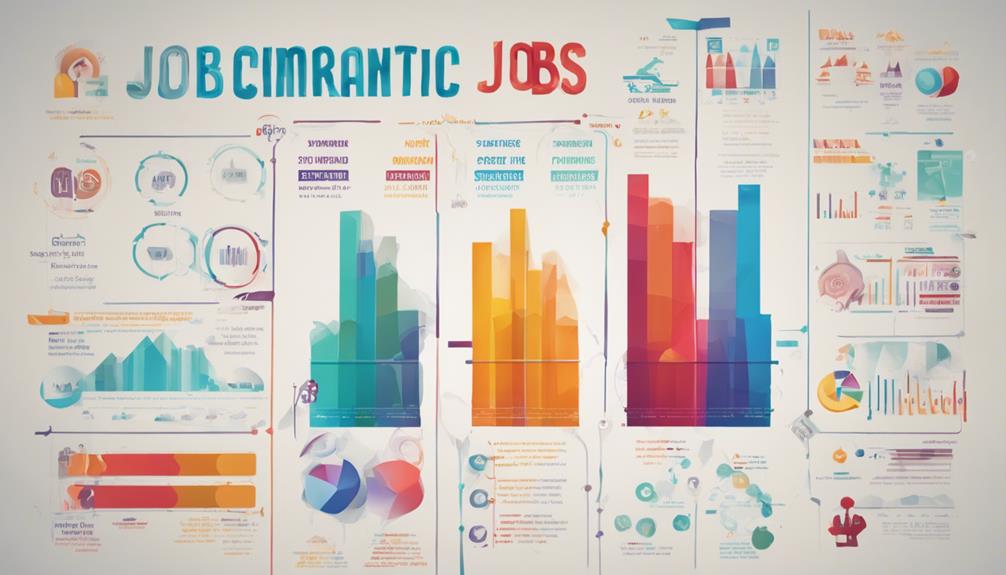In 2023, the highest-paying job is that of a software developer, offering a median salary of $120,000. This position demonstrates robust demand, with a projected employment growth rate of 26% over the next decade. Following closely are nurse practitioners and medical and health services managers, both highlighting the rising need for skilled healthcare professionals. These careers not only provide competitive compensation but also emphasize job security and work-life balance. As industries evolve, understanding these trends can inform career choices. To explore more insights about the job market and emerging opportunities, continue to learn about the latest developments.
Key Takeaways
- The top-paying job in 2023 is a Software Developer, with a median salary of $120,000.
- Software development is projected to grow by 26% over the next decade, indicating high demand.
- Nurse Practitioners and Medical Managers also rank high, reflecting the increasing need for healthcare professionals.
- Job security, competitive salaries, and work-life balance are key factors making these roles attractive.
Overview of Top-Paying Jobs

The landscape of top-paying jobs in 2023 reveals a dynamic interplay of high demand, lucrative salaries, and promising growth potential, particularly within the fields of technology and healthcare. For example, software development roles, data analysis positions, and cybersecurity experts continue to be in high demand, with competitive salaries and opportunities for career advancement. Similarly, the healthcare industry is seeing a surge in demand for healthcare administrators, nurse practitioners, and physician assistants, all of whom can expect to receive generous compensation for their expertise. These trends reflect a passiondriven NFL decision to invest in these rapidly growing sectors, offering attractive opportunities for job seekers looking for high-paying and meaningful work.
Leading the rankings is the software developer position, offering an impressive median salary of $120,000 and a projected employment growth rate of 26% over the next decade.
Following closely are nurse practitioners and medical and health services managers, reflecting the increasing need for healthcare professionals.
These roles not only provide competitive compensation but also emphasize job security and work-life balance, making them attractive career choices.
Key Job Rankings for 2023

Highlighting the top job rankings for 2023, several positions stand out for their strong salaries, growth potential, and job security. The U.S. News & World Report's annual rankings showcase a diverse range of careers that are thriving in today's economy.
Key positions include:
- Software Developer – Ranked as the best job with a median salary of $120,000, reflecting high demand across industries.
- Nurse Practitioner – Securing the second spot, this role offers excellent job security and rewarding compensation.
- Medical and Health Services Manager – Positioned third, this career highlights the ongoing growth in the healthcare sector.
These rankings illustrate a clear trend toward technology and healthcare professions, emphasizing their significance in the current job market.
Factors Impacting Job Rankings

Several key factors influence job rankings, including median salary, job security, growth potential, and employee satisfaction.
Median salary serves as a critical benchmark, reflecting the financial rewards associated with a profession.
Job security is essential, as positions with lower unemployment rates tend to rank higher due to their stability.
Growth potential, analyzed through projected job openings and industry demand, indicates future opportunities within a field.
Employee satisfaction, often gauged through surveys and interviews, showcases the overall well-being of workers in various roles.
Additionally, stress levels and work-life balance contribute to the desirability of positions, impacting how they are perceived within the job market.
Together, these factors create a thorough framework for evaluating the attractiveness of various career paths.
Employment Trends and Projections

Employment trends indicate a significant shift towards technology and healthcare sectors, with software development leading the charge in job growth and demand. Analysts project a 26% increase in software developer positions from 2021 to 2031, reflecting the sector's robust expansion.
This shift is driven by several key factors:
- Technological Advancements: Continued innovation fuels the need for skilled developers to create and maintain software solutions.
- Healthcare Demand: The growing need for healthcare services guarantees strong job security for professionals like nurse practitioners and medical managers.
- Resilience in the Workforce: A notable 72% of laid-off tech workers secured new positions within 90 days, showcasing the sector's adaptability and ongoing opportunities.
These trends highlight the promising future for both technology and healthcare careers.
Career Development Insights

To navigate the evolving job landscape successfully, individuals must prioritize continuous skill development and adaptability to industry changes.
Emphasizing lifelong learning is critical, as industries increasingly value versatile employees who can pivot in response to new technologies and market demands.
Networking remains an essential strategy, providing opportunities for mentorship and collaboration.
The rise of remote work has also transformed job dynamics, leading to greater flexibility and a better work-life balance, which are key for job satisfaction.
Additionally, cultivating an entrepreneurial mindset can empower professionals to explore innovative pathways and career shifts, further enhancing their marketability.
Frequently Asked Questions
What Qualifications Are Needed to Become a Software Developer?
To become a software developer, individuals typically require a bachelor's degree in computer science or a related field, proficiency in programming languages, strong problem-solving skills, and experience with software development methodologies and tools.
How Does Job Satisfaction Vary Among Top-Paying Jobs?
Like a finely tuned orchestra, job satisfaction among top-paying professions varies considerably, influenced by factors such as work-life balance, stress levels, and personal fulfillment. Understanding these dynamics is essential for career success and retention.
What Industries Are Hiring Software Developers the Most?
Software developers are in high demand across various industries, including technology, finance, healthcare, and e-commerce. Their versatile skill set allows them to contribute greatly to digital transformation and innovation initiatives, enhancing operational efficiency and user experience.
Are There Specific Programming Languages in High Demand?
Yes, specific programming languages currently in high demand include Python, JavaScript, Java, C#, and Go. Proficiency in these languages aligns with industry needs, enhancing job prospects in software development and technology sectors.
What Are Common Career Paths for Software Developers?
Common career paths for software developers include roles such as software engineer, systems architect, and DevOps engineer. Additionally, many shift into management positions or specialize in fields like cybersecurity, data science, or mobile app development.
Conclusion
In the ever-evolving landscape of employment, the ascent of software developers as the pinnacle of lucrative careers illuminates the profound interplay between technology and professional opportunity.
As industries increasingly embrace digital transformation, the demand for skilled practitioners remains insatiable.
This year's rankings not only reflect current market dynamics but also serve as a compass for aspiring professionals steering their career paths.
Embracing continuous learning and adaptability will be paramount in seizing the opportunities that lie ahead.









